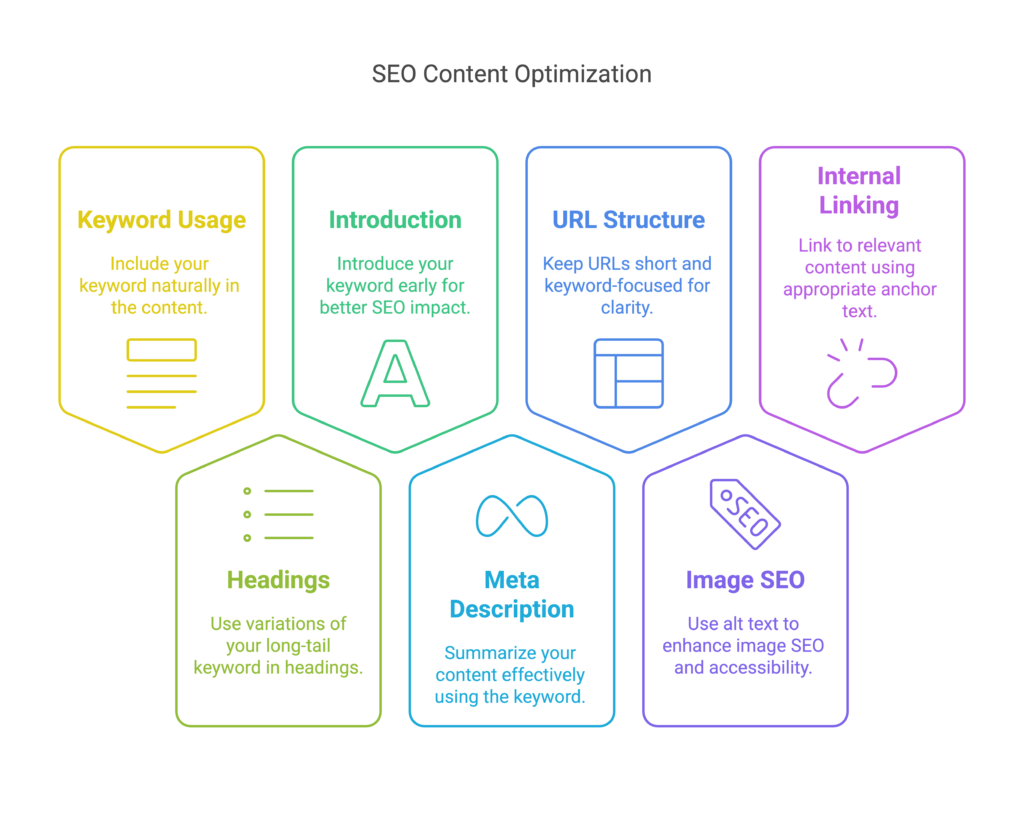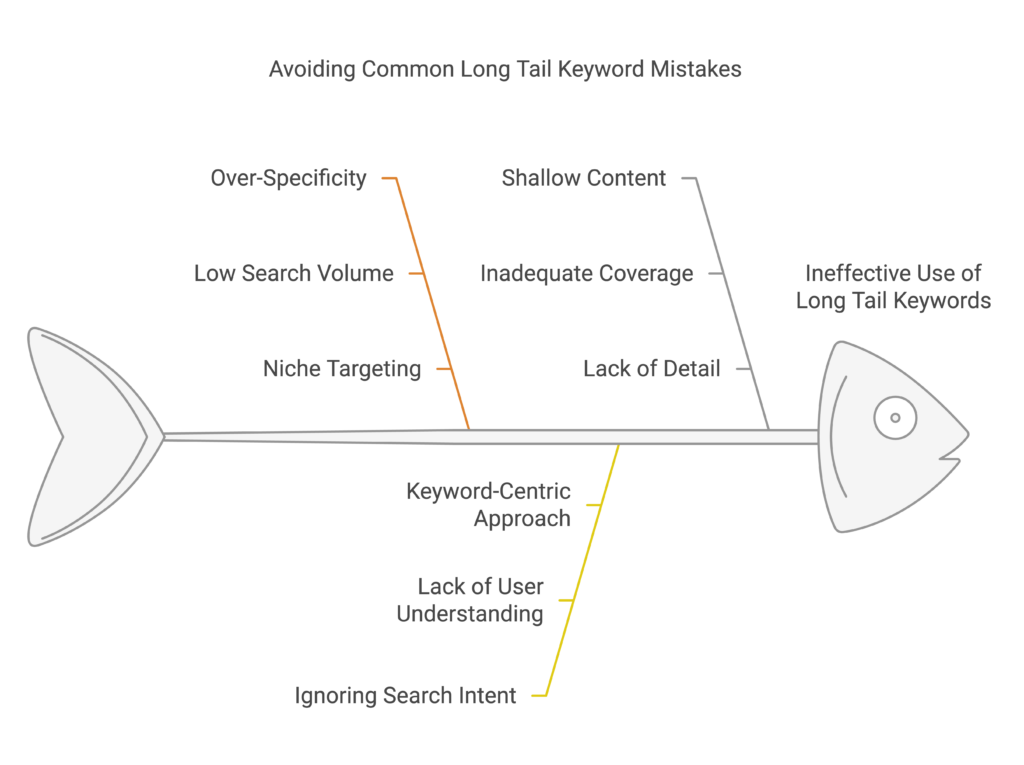What is a long-tail keyword in SEO? How to use long-tail keywords for SEO strategy? Where do I find these keywords as a beginner? Are long tail keywords better than other keyword variations? If you have these questions, stay here! Long tail keywords are not just long phrases, they can also multiply the chances of your site’s appearance in organic results by manifold when used correctly.
In this beginner-friendly guide, we’ll cover what long-tail keywords are, why they matter, and how you can use them to improve your SEO strategy and get more targeted traffic to your website.
1. What is a Long-Tail Keyword?
First things first! A long-tail keyword is a longer, more specific search phrase that people use when they are closer to making a decision online. Unlike short, broad keywords, the topic of our discussion – the mighty ‘long-tail keywords’ usually have lower search volume but higher conversion rates.
Here’re long tail keyword examples for beginners:
- Short-tail keyword: “shoes” (very broad, highly competitive)
- Long-tail keyword: “best running shoes for flat feet” (more specific, highly targeted and is easier to rank for)
Features of long-tail keywords
- Longer (typically 3+ words)
- More specific and targeted (as mentioned above)
- Lower competition than short keywords (since not many sites are trying to rank for them)
- Higher conversion rates (more chance of a searcher making an action)
- Match search intent better (using more specific, longer phrases means better matching of a searcher’s search intention)
2. Why are long-tail keywords important for SEO?
The importance of long tail keywords in SEO is immese!
Many beginners assume that ranking for popular short keywords (like “SEO” or “blogging”) is the best strategy. However, those keywords are highly competitive. What it means is that those keywords are difficult to rank. More so for new websites with no or very little online presence. The below points answer your question: Are long keywords better?
Less competition = Easy to rank
Since fewer websites compete for long-tail keywords, your content has a good chance of ranking on Google, Bing, DuckDuckGo and other search platforms.
More relevant traffic
Long-tail keywords attract visitors who are looking for what you offer. It results in higher engagement with no strings attached!
Higher Conversion Rates
People searching for specific queries, highly targeted and intent-based ones (for example, “best budget laptops for students in 2025”) are often likely to make an action (here a strong purchase is a core intent).
Voice Search Optimization
With the rise of voice search (Google Assistant, Alexa, Siri), more users are searching in natural, conversational phrases, which are often long-tail keywords. Note that action driven phrases are often long tail ones.
3. How to find long-tail keywords for SEO?
Now that you understand why long-tail keywords matter and are better for SEO, how do you find them? Here are some free tools and techniques:
Use Google’s Auto-Suggest
Start typing a keyword in Google, and look at the suggested phrases. These are real searches people are making.
“People Also Ask” & Related Searches
Scroll down the search results page to find related queries. These are great long-tail keyword ideas!
Free SEO Tools
There are plenty out there! But you can get started with these two
- AnswerThePublic (for question-based keywords)
- Ubersuggest (gives long-tail variations of keywords)
Check Forums & Q&A Sites
Browse platforms like Reddit, Quora, and niche forums to see how real users phrase their questions.
How to Use Long-Tail Keywords in Your Content?
Finding long-tail keywords is just the first step. Now, you need to strategically place long tail keywords in your content:
- Title: Include your keyword naturally
- Headings (H2, H3): Use variations of your long-tail keyword
- First 100 words: Introduce your keyword early for SEO
- Meta Description: Summarize your content with the keyword
- URL: Keep it short and include the main keyword
- Image Alt Text: Helps with image SEO and accessibility
- Internal Links: Link to relevant content using anchor text with your keyword

5. Real-life examples: Success with long-tail keywords
Let me share my own experience here. While there are plenty of them, I would specifically cover one case study to signify the immense potential these long phrases hold to boost your organic rankings. You can follow the link below to read the case study.
If you’re in hurry, here’s the summary: We picked long tail low competitive keuwords for a jewellery brand, created conversion worthy and SERP topping content around those keywords and optimized the content based on SEO best practices. The site got ranked quickly, not just becuase we targerted the right keywords, but the content published was highly relevant and intent-driven.
When I wrote the content published was of quality, I was referring to an important discussion without which this article would be left imcomplete. Just using keywords and populating them evenly into the content is not enough. The content must be the best. let me dig futher.
How to use long tail keywords effectively in SEO?
Success with long tail keywords comes from smart implementation:
- Create in-depth content: Don’t just sprinkle these long, wordy phrases throughout thin content. Write comprehensive guides that practically address the specific topic. For example, if your long tail keyword is “how to start a container garden on a sunny balcony,” create a complete guide covering everything from container selection to plant choices.
- Focus on user intent: Understand why someone is searching for this specific phrase. Are they looking to buy something? Learn something? Solve a problem? Shape your content to match their wide ranging intents.
- Keep It natural: Never force keywords into your content. Write for humans first, search engines second.
Common mistakes to avoid using long tail keywords (Summarizing the don’ts)
- Targeting too specific keywords: While long tail keywords are specific, ensure there’s still search volume. “red polka dot running shoes for left-handed marathon runners” might be too niche.
- Ignoring search intent: Don’t just focus on the keyword itself. Understand and address why someone is searching for this term.
- Creating shallow content: Long tail keywords deserve in-depth content that thoroughly addresses the topic.

FAQs About Long-Tail Keywords
1. Are long-tail keywords better than short-tail keywords?
It depends on your goal. Short-tail keywords have more traffic but are harder to rank. Long-tail keywords bring more targeted traffic and are relatively easier to rank.
2. How many long-tail keywords should I use per content?
Use 1-2 primary long-tail keywords and naturally include related variations throughout your content.
3. Can long-tail keywords help with voice search?
Yes! People use longer, more conversational queries when using voice search.
4. How to find long tail keywords for free?
Free tools like Google Autocomplete, AnswerThePublic, and Ubersuggest are great for finding long-tail keywords. Semrush also provides limited keyword search results for users with free plan.
Start Using long-tail keywords, they help when used properly!
If you’re a beginner in SEO, and trying to leverage on long-tail keywords, this guide should have helped you understand the basics. These keywords help you rank faster, attract targeted traffic, and improve conversions but make sure they are not overused and used wrongly.
If you have questions about long-tail keywords, drop them in the comments below and I will answer them.




